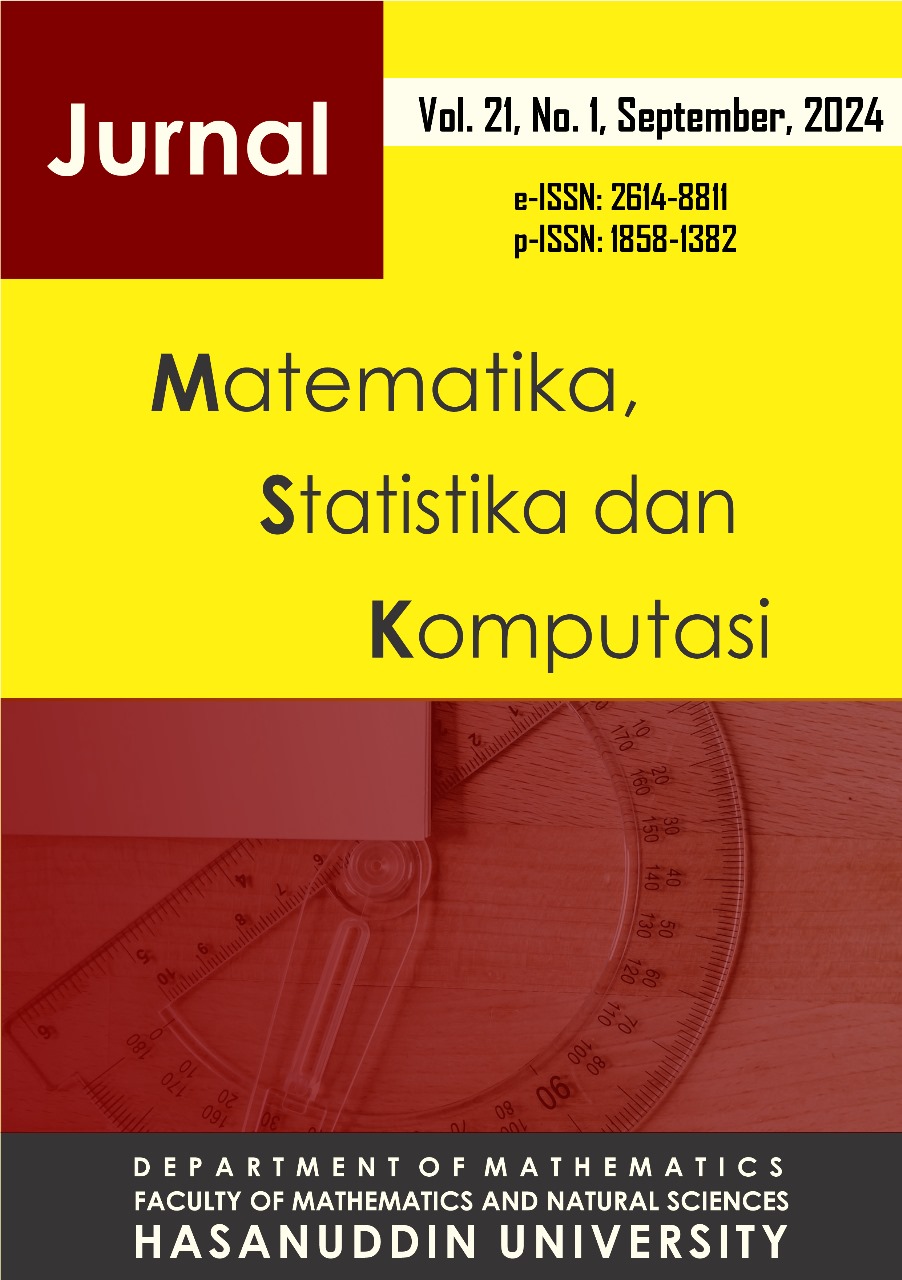Factors Affecting The Number Of Domestic Flights In Indonesia During Covid-19 Pandemic Using SARIMAX Method
DOI:
https://doi.org/10.20956/j.v21i1.34557Keywords:
SARIMAX, COVID-19, domestic flightAbstract
Indonesia, which consists of thousands of large and small islands, relies heavily on-air transportation to support mobility between regions. As many as 80% of Indonesia's total air transportation passengers are domestic flight passengers. This shows how vital domestic flights are in Indonesia's air transportation system. However, in 2020, the COVID-19 pandemic had an impact that resulted in a decrease in the number of domestic flights in Indonesia. Therefore, an analysis is needed to determine the factors that affect the number of domestic flights in Indonesia. This study uses the SARIMAX method, a time series regression with the addition of seasonal factors and other variables or exogenous factors that significantly affect the model to improve the model's accuracy. Several exogenous variables are considered, including the number of operating civil aviation airports, positive daily cases of COVID-19, calendar effects during Eid al-Fitr and New Year's Day, and social restriction policies. The results showed that the number of operating airports one week before Eid al-Fitr, one week during Eid al-Fitr, one week before New Year, and Emergency PPKM significantly influenced the number of domestic flights. These variables offer pivotal insights into the influence of external factors on domestic flight patterns, exerting significant impacts on passenger travel behavior and subsequently influencing domestic flight volume. The integration of these variables in the SARIMAX model allows for a comprehensive analysis of the complex dynamics influencing domestic air travel in Indonesia. The best SARIMAX model obtained is SARIMAX (1,1,1)(4,1,1)7 with a MAPE value of 5.35% and a coefficient of determination is 97%.
References
Bowerman, B. L. & O'Connell, R. T., 1993. Forecasting and Time Series : An Applied Approach. California: Duxbury Press.
BPS, 2021. Statistika Transportasi Udara. Jakarta: BPS RI.
Kemenhub, 2005. Keputusan Menteri Perhubungan Republik Indonesia Nomor KM 49 Tahun 2005 Tentang Sistem Transportasi Nasional, Jakarta: Sekretariat Negara.
Khairunnisa, S. et al., 2020. Forecasting and Effectiveness Analysis of Domestic Airplane Passengers in Yogyakarta Adisutjipto Airport with Autoregressive Integrated Moving Average with Exogeneous (ARIMAX) Model. Proceeding International Conference on Science and Engineering, Volume 3, pp. 365-369. https://doi.org/10.14421/icse.v3.529.
Lestari, D. & Sigit, P., 2020. Faktor – Faktor yang Mempengaruhi Perkembangan Angkutan Udara Rute Sumenep – Surabaya pp. Jurnal Manajemen Aset Infrastruktur & Fasilitas, 4(2), pp. 149 - 166. https://doi.org/10.12962/j26151847.v4i2.6888.
Sabur, F., 2019. Pengaruh Pergerakan Pesawat Komersial Terhadap Pergerakan. Jurnal Teknik dan Keselamatan Transportasi, 5(2), pp. 151 - 155. https://doi.org/10.46509/ajtk.v2i1.90.
Soehardi, S. A. H. H. S. T. &. H. N. E., 2020. Pengaruh Pandemik Covid-19 Terhadap Wisatawan Mancanegara Dan Nusantara Serta Karyawan Perusahaan Penerbangan Di Indonesia. Jurnal Ilmiah Manajemen Ubhara, 2(2), pp. 46-60. http://dx.doi.org/10.31599/jmu.v2i2.769.
Suropati, H., 2022. PERAMALAN PASAR TRANSPORTASI UDARA DOMESTIK INDONESIA PASCAPANDEMI COVID-19. Jurnal Transportasi, 22(3), pp. 227-236. https://doi.org/10.26593/jtrans.v22i3.6351.227-236.
Tolcha, T. D., 2023. The state of Africa's air transport market amid COVID-19, and forecasts for recovery. Journal of Air Transport Management, 108(349) .
https://doi.org/10.1016/j.jairtraman.2023.102380.
Wei, W. W. S., 2006. Time Series Analysis: Univariate and Multivariate Methode (Second Edition). s.l.:Pearson Prentice Hall.
Xu, S., Chan, H. K. & Zhang, T., 2019. Forecasting the demand of the aviation industry using hybrid time series SARIMA-SVR approach. Transportation Research Part E : Logistics and Transportation Review, Volume 122, pp. 169-180. https://doi.org/10.1016/j.tre.2018.12.005.
Zahra, J. S. & Prastuti, M., 2023. Peramalan Jumlah Penumpang Pesawat Domestik di Bandara Soekarno-Hatta pada Masa Pandemi Covid19 Menggunakan ARIMAX dengan Model Intervensi. JURNAL SAINS DAN SENI ITS, 12(1), pp. 2337-3520.
https://doi.org/10.12962/j23373520.v12i1.100847
Gudmundsson, S., Cattaneo, . M. & Redondi, R., 2021. Forecasting temporal world recovery in air transport markets in the presence of large economic shocks: The case of COVID-19. Journal of Air Transport Management, Volume 91. https://doi.org/10.1016/j.jairtraman.2020.102007.
Önen, V., 2023. Using the ARIMA and ARIMAX Methodologies to Estimate, Model, Forecast, and Compare Airline Passenger Transportation Demand in Türkiye. Journal of Transportation and Logistics, 8(2), pp. 242-273. https://doi.org/10.26650/JTL.2023.1270944.
Downloads
Published
How to Cite
Issue
Section
License
Copyright (c) 2024 Jurnal Matematika, Statistika dan Komputasi

This work is licensed under a Creative Commons Attribution 4.0 International License.

This work is licensed under a Creative Commons Attribution 4.0 International License.
Jurnal Matematika, Statistika dan Komputasi is an Open Access journal, all articles are distributed under the terms of the Creative Commons Attribution License, allowing third parties to copy and redistribute the material in any medium or format, transform, and build upon the material, provided the original work is properly cited and states its license. This license allows authors and readers to use all articles, data sets, graphics and appendices in data mining applications, search engines, web sites, blogs and other platforms by providing appropriate reference.







